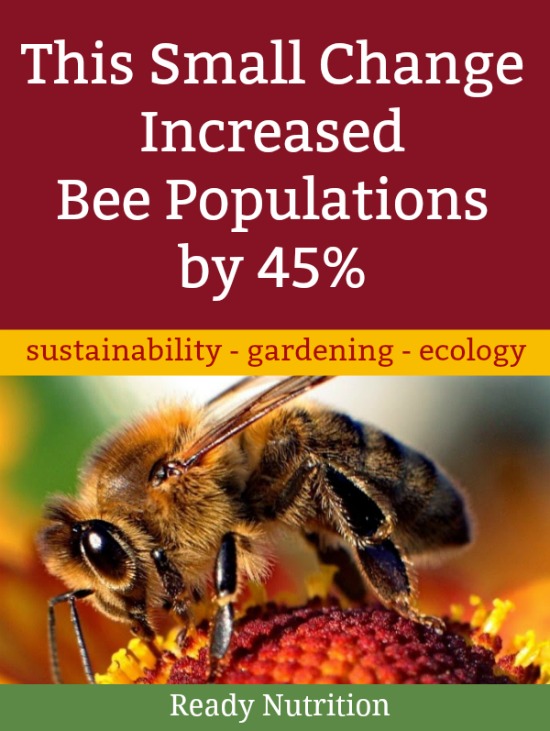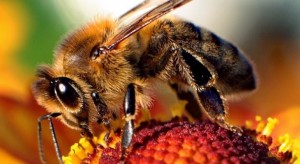We’ve known for years [1] that bee populations all across North America and Europe are collapsing at an alarming rate.
Our very existence relies on the tiny buzzing creatures, as we explained in Will the Extinction of Bees Really Mean the End of Humanity? [2]
This is a huge threat to our food supply. One-third of all the food we eat comes from plants that are pollinated by insects, and 80% of those crops are pollinated by bees [3]. It also has big implications for our meat supply as well: plants (like alfalfa) that feed animals are pollinated by bees.
The largest international survey of insect pollinators found [4] that just 2 percent of wild bee species now account for 80 percent of global crop pollination.
Put bluntly, if all the bees die, humanity will follow.
There is one place where bee populations are growing and flourishing – Amsterdam, the capital city of the Netherlands.
According to a recent report from NBC News [5], the diversity of wild bee and honeybee species in the Dutch capital has increased by 45 percent since 2000!
The city of 2.3 million people attributes the success to creating bee-friendly environments like the overgrown, sunburnt patch of shrubs that commuters pass by daily.
The installation of “insect hotels” and a ban on the use of chemical pesticides on public land also appear to have played a role.
Geert Timmermans, an ecologist who works for the city, explained that four years ago, Amsterdam set a goal to convert half of all public green spaces to native plants. He added that residents and local businesses are provided with information on how to avoid using pesticides and the use of alternative treatments:
“Insects are very important because they’re the start of the food chain. When it goes well with the insects, it also goes well with the birds and mammals.
Our strategy is to when we design a park, we use native species but also the species that give a lot of flowering and fruit for (bees).
(Citizens) acknowledge the importance of the natural environment. It’s part of the culture.”
The city also employs what Timmermans calls a “nature-inclusive” ideology in its design plans:
Developers are also encouraged to install green roofs on new buildings, which help control the climate within the structure, reducing reliance on heating and cooling systems, and also create a better habitat for wildlife.
Subsidies are available through the city for residents and owners looking to retrofit existing roofs or exterior walls.
City ecologists are helping residents determine where and what to plant in their neighborhoods to support healthy populations of bees, bats, and birds.
Their project appears to be working: a 2015 survey of pollinators found 21 bee species not previously documented in the city, according to the NBC News report.
Other projects are also helping the pollinator community regain its health.
Deborah Post, who lives in a rural area outside of Amsterdam, founded Honey Highway [6] so she could do her part to save the tiny creatures when the honey bees in her own apiary began dying off:
With a new highway being built in the area in 2015, she pitched to government and developers to allow her to sow wildflowers along the sides of the road that would typically be left with only gravel or grass. The experiment was a success.
Building on the experience, Post expanded Honey Highway, sowing flowers along other major routes and also along dikes and railways.
The flowers she uses are all native to Holland and chosen based on what is most likely to thrive in a given area.
Other regions have implemented “bee highways” as well. A few years ago, Oslo, Norway, created a bee highway [7] with feeding stations. The public and local business owners were asked to plant bee-friendly plants on their property, rooftops, and businesses along a route from east to west through the city.
Threats to bee and pollinator populations include human destruction of habitats, the use of harmful chemicals like glyphosate [8] (found in products like Monsanto’s RoundUp), and antibiotic overuse.
Bees – like humans – have a gut microbiome (an ecosystem of bacteria living in the digestive tract, including those that protect it from harmful bacteria) that is crucial to its survival. A study [8] conducted at the University of Texas in Austin in 2018 found that honey bees exposed to glyphosate lose some of the beneficial bacteria in their guts. This makes the bees more susceptible to infection and death from harmful bacteria.
In 2017, researchers at the same university found [9] that treatment with the common antibiotic tetracycline were “half as likely to survive the week after treatment compared with a group of untreated bees.”
“In large-scale U.S. agriculture, beekeepers typically apply antibiotics to their hives several times a year. The strategy aims to prevent bacterial infections that can lead to a widespread and destructive disease that afflicts bee larvae,” the researchers explain in a press release [9].
The scientists found that after treatment with tetracycline, bees had dramatically fewer naturally occurring gut microbes (healthy bacteria that can help to block pathogens, break down toxins, promote absorption of nutrients from food and more).
They also found elevated levels of Serratia, a pathogenic bacterium that afflicts humans and other animals, in the bees treated with antibiotics, suggesting that the increased mortality might have been a result of losing the gut microbes that provide a natural defense against the dangerous bacteria.
What YOU can do to help bees
As Tess Pennington explained in the article First Bee Highway Set Up in Oslo [7], any community can create a bee highway, and individuals can plant bee-friendly gardens on their property.
Consider planting some of these beneficial flowers:
- Asters (Aster/Callistephus)
- Sunflowers (Helianthus/Tithonia)
- Salvia (Salvia/Farinacea-Strata/Splendens)
- Bee balm (Monarda)
- Hyssop (Agastache)
- Mint (Mentha)
- Cleome / Spider flower (Cleome)
- Thyme (Thymus)
- Poppy (Papaver/Eschscholzia)
- California poppies (Eschscholzia)
- Bachelor’s buttons (Centaurea)
- Lavender (Lavandula)
Choosing flowers with long bloom cycles will be less work for you and help bees for months on end. Many of the flowers listed above are drought-tolerant and can be grouped together to reduce watering requirements (for more on Xeriscaping – building a sustainable system that creates regionally appropriate landscaping, conserves water, and reduces your water bill – read Sustainable Gardening: Reduce Watering by 50-75% [10]).
Fruit trees are also wonderful for pollinators and are an abundant source of blossoms.
Build nests for native bees. They are easy to make – instructions can be found here [11].
Bees should also have a source of water in the garden too. Birdbaths, water fountains, and small ponds are great for bees.
Remember not to use any chemical-based fertilizers on plants as this will harm bees.
Glyphosate isn’t the only thing that can harm bees. Pesticides can as well. In particular, steer clear of systemic pesticides such as neonicotinoids [12], which are taken up by the vascular systems of plants. This means bees and other pollinators are exposed to the poison long after a product has been applied when they feed on the plant’s nectar and pollen.
Here are some additional things you can do to help bees and other pollinators thrive in your yard:
- When purchasing plants, ask your garden supplier to ensure that they have not been treated with neonicotinoids or other systemic pesticides.
- Instead of using pesticides, use a “companion planting” system to discourage pests from making an all-you-can-eat buffet of your garden. For more on sustainable pest management, please see this guide [13] from Xerces Society.
- Provide flowering plants [14] from April through October (early spring through fall).
- Fruit trees typically bloom early in the spring, which is a critical time for foraging bumblebee queens. Try to ensure that your new plants have not been treated with neonicotinoids or other systemic pesticides. Avoid invasive non-native plants and remove them if they invade your yard.
- Plant native wildflowers that bloom throughout the year in containers on your windowsill, porch or deck, or in your garden. Since these flowers attract bumblebees and other pollinators, they will enhance pollination of your fruit and vegetable crops too.
- Because most queens overwinter in small holes on or just below the ground’s surface, avoid raking, tilling or mowing your yard until April or May. If you do need to mow, do so with the mower blade set at the highest safe level.
- Many native bumblebees build their nests in undisturbed soil, abandoned rodent burrows, or clumps of grass. Preserve un-mown, brushy areas and do not destroy bumblebee nests when you find them. Reduce soil tilling and mowing where bumblebees might nest.
- Here’s how to protect bee habitats during the fall and winter months: Put Down Those Pruners: Pollinators Need Your ‘Garden Garbage!’ [15]
For more information on companion planting for natural pest control, here’s an in-depth guide: The Organic Gardener’s Handbook of Natural Pest and Disease Control: A Complete Guide to Maintaining a Healthy Garden and Yard the Earth-Friendly Way [16].
Report the bees you see in your yard or community to Bumble Bee Watch [17], a citizen-science project sponsored by the Xerces Society and five North American partners.
 [18]
[18]